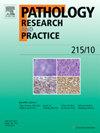Unveiling four axes ADAMTS9-AS2|MEG3/hsa-miR-150/PRKCA|MMP14 within prostate cancer through establishment of the ceRNA network
IF 2.9
4区 医学
Q2 PATHOLOGY
引用次数: 0
Abstract
Prostate cancer is among the most common cancers in males. Recent application of system biology methods has resulted in identification of key genes in the process of carcinogenesis. In the current study, we selected two datasets related to prostate cancer (PCa) and performed bulk RNA-seq analysis by selecting samples with Gleason scores greater than 7 and combining them. Subsequently, using several systems biology approaches, we constructed the ceRNA network and ultimately identified key axes related to PCa. Our analyses revealed importance of ADAMTS9-AS2/miR-150/PRKCA, ADAMTS9-AS2/miR-150/MMP14, MEG3/miR-150/PRKCA and MEG3/miR-150/MMP14 with miR-150 being a central component. Remarkably, miR-150 exhibited strong statistical significance in survival analyses. Further, analyzing expression levels from TCGA datasets, the expression of the identified genes associates significantly with prostate cancer compared to normal tissue confirming the bioinformatic analyses. Therefore, these genes can be regarded as prognostic markers in prostate cancer and the pathways are potential targets for therapeutic interventions.
通过建立ceRNA网络,揭示前列腺癌中ADAMTS9-AS2|MEG3/hsa-miR-150/PRKCA|MMP14的四条轴线
前列腺癌是男性最常见的癌症之一。近年来,系统生物学方法的应用已发现了致癌过程中的关键基因。在本研究中,我们选择了两个与前列腺癌(PCa)相关的数据集,并通过选择 Gleason 评分大于 7 分的样本并将其合并,进行了批量 RNA-seq 分析。随后,我们利用多种系统生物学方法构建了ceRNA网络,并最终确定了与PCa相关的关键轴。我们的分析揭示了ADAMTS9-AS2/miR-150/PRKCA、ADAMTS9-AS2/miR-150/MMP14、MEG3/miR-150/PRKCA和MEG3/miR-150/MMP14的重要性,其中miR-150是核心成分。值得注意的是,miR-150 在生存分析中表现出很强的统计学意义。此外,通过分析 TCGA 数据集的表达水平,与正常组织相比,已发现基因的表达与前列腺癌有显著相关性,这也证实了生物信息学分析的结果。因此,这些基因可被视为前列腺癌的预后标志物,其通路也是治疗干预的潜在靶点。
本文章由计算机程序翻译,如有差异,请以英文原文为准。
求助全文
约1分钟内获得全文
求助全文
来源期刊
CiteScore
5.00
自引率
3.60%
发文量
405
审稿时长
24 days
期刊介绍:
Pathology, Research and Practice provides accessible coverage of the most recent developments across the entire field of pathology: Reviews focus on recent progress in pathology, while Comments look at interesting current problems and at hypotheses for future developments in pathology. Original Papers present novel findings on all aspects of general, anatomic and molecular pathology. Rapid Communications inform readers on preliminary findings that may be relevant for further studies and need to be communicated quickly. Teaching Cases look at new aspects or special diagnostic problems of diseases and at case reports relevant for the pathologist''s practice.

 求助内容:
求助内容: 应助结果提醒方式:
应助结果提醒方式:


